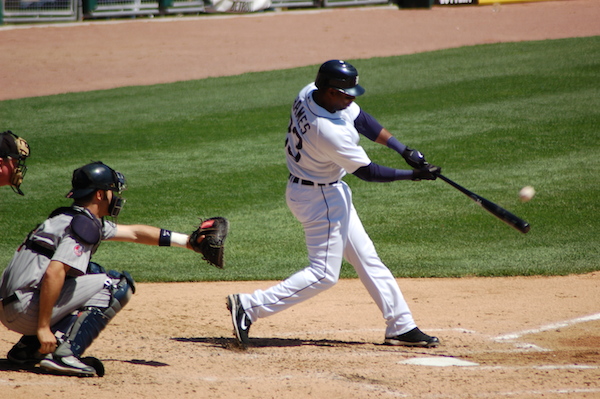Dear Sports Fan,
Can someone explain to me how batting averages are calculated, and what the .000 etc. means?
Thanks,
Dot Dot Dot
Dear Dot Dot Dot,
Batting averages in baseball somehow manage to be deceptively simple and deceptively complicated at the same time. We will start with the simple and then move to the complicated.
Batting averages look weird — they usually range from around .200 to .375 but don’t be fooled, it’s just a percentage expressed with one decimal point. So, the odd looking .200 is 20.0% and .375 is 37.5%.
But!
Things get more complicated when we start reasoning about what exactly the batting average percentage is made up of.
- Batting average = the number of hits / the number of at bats
- Hits = when the batter safely reaches first base after hitting the ball into fair territory, without the benefit of an error or a fielder’s choice
- Fair territory = you know, between the lines from home to first and home to third which extend out to infinity
- Error = when someone official sitting in the stands decides that a fielder has messed up in such a way that allowed the runner to advance when they normally wouldn’t
- Fielder’s choice = When the fielder gets to catch the ball either in his glove or his hat![1]
- At bat = every time a person comes to the plate except when he gets a walk, is hit by a pitch, hits a sacrifice, is awarded first base due to interference or obstruction, the inning ends while he is still trying to get a hit — likely due to a base runner being thrown out, or he is replaced by another hitter.
- Walk = the opposite of “three strikes and you’re out,” this is “four balls and you’re on”
- Hit by a pitch = hit by a pitch — you get to advance to first base if this happens
- Sacrifice = this is by itself complicated, but basically a hit is a sacrifice if you intentionally hit the ball where you’re likely to be out, but it helps one of your teammates who is already on base, advance from first to second, second to third, or third to home.
- Interference or obstruction = the catcher can’t tickle the batter while he is trying to bat
- Inning ends probably due to someone getting thrown out = if someone tries to steal a base when their team already has two outs in the inning and they fail, then the inning will be over
- Replaced by another hitter = when the coach decided this guy is not going to get it done and replaces him in the middle of an at bat[2]
Got that? Right, so this really does seem needlessly complicated. And the problem is that the complication masks something really important. Batting average is a crappy measure! Check this out. According to batting average, these players are all exactly the same over 10 at bats:
- Player A: two home runs, one triple, seven strike-outs
- Player B: three singles, seven strike-outs
- Player C: three singles, three walks, four strike-outs
All three players would have a batting average of .300 but you tell me which you would want on your team! Player B is obviously worse than A or C. It’s a close match between A and C for me — A is certainly a more powerful guy, but C managed to at least get to first base six out of 10 times at the plate. That’s remarkable! Since the 1970s there has been a slow but increasingly accepted revolution against batting average and many of the other traditional statistics led by the guys at SABR — the Society For American Baseball Research. They and their intellectual descendants have sought to replace the old stats with new, more meaningful ones with really silly abbreviations like: BABIP, DIPS, OPS, VORP, WAR, and the always important LIPS.
Those are a story for another time… until then, we’ll leave you with this:
Adios,
Ezra Fischer


did you just figure out how to do footnotes?
Nope! We’ve been doing them with this hover-over thing for a while now. What do you think of the format?
Player C has a higher batting average than the other two, walks don’t count as at bats. So C is 3/7 while the others are 3/10.
Arghh! Dammnit — I knew I would mess it up! At least now it’s a “teaching moment” thanks to you.
Glad I am not the only one trying to understand. Thanks to this year’s world series, I wanted to understand
Thanks for reading! This year’s world series has been exciting!